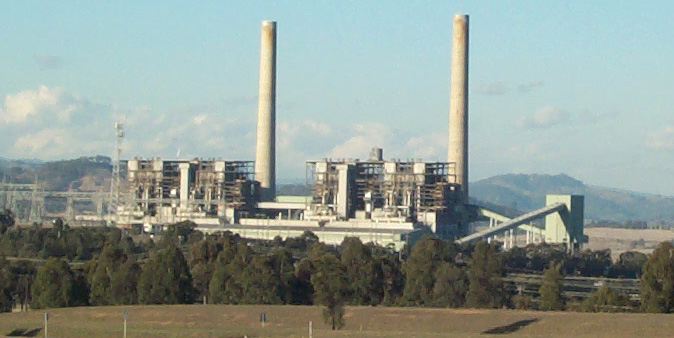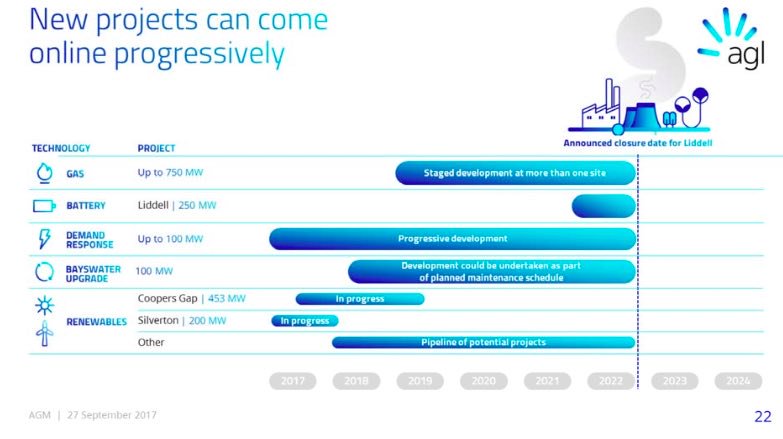The plan – yet to be finalised – was unveiled at the company’s annual general on Wednesday by CEO Andy Vesey, and came after chairman Jerry Maycock voiced his support for Vesey and outlined the reasons why trying to keep Liddell open for five more years was a bad idea.
AGL has come under huge pressure from the Coalition government and the conservative media to keep Liddell open, despite warning that it would become increasingly expensive to operate and increasingly unreliable. Maycock said it made sense to invest in new technologies.
“We will deploy both grid-scale batteries, as well as residential batteries combined with orchestration technology to enable customers to participate in and benefit financially from demand response,” he said.
Such a battery storage installation – it did not give any details of how many hours of storage – would be the biggest in Australia, although it seems certain that once the Tesla big battery is completed in South Australia then other major projects will follow.
AGL is also half way through its first virtual power plant – linking household storage via smart software to deliver a “virtual” power plant equivalent to 5MW of solar power. It appears to be thinking along the same lines to help replace Liddell.
Other firm capacity would come from an upgrade of the neighbouring Bayswater coal generator – due to close in 2035 – which could add 100MW, as well as investment in new gas capacity (750MW) to help meet the 1,000MW of reserve capacity shortfall identified by the Australian Energy Market Operator.
But most of the 8 terawatt hours that Liddell curently produces – much of it at night when the need is less – will be replaced by new renewable energy projects, because they are the cheapest options.
“We believe the bulk of the 8 terawatt hours of energy needed to match Liddell’s output can come from new renewables projects, as we believe this is the most cost-effective option,” Vesey said.
“That would include our Coopers Gap and Silverton projects already under construction, other projects from within our pipeline, and other companies’ projects as well.
“And, of course, the intermittency of wind and solar generation means additional firm, flexible, dispatchable capacity is also required.”
Vesey used this table above to illustrate the potential time-line of the various projects. Inerstintly, the battery storage installation is slated for completion around 2022 – meaning that it is likely to benefit from considerable cost falls between now and then. Analysts put these costs falls at potentially 50 per cent or more.
The two wind farms are already being built, and another 3,000MW of wind and solar could be built over the coming four or five years.
“Our plans will be flexible, enabling us to increase or decrease our own investment depending on the broader response of the market to price signals and policy certainty,” Vesey said.
Popular content
“Before we present our final plans to the Federal Government and AEMO, we have more work to do on refining the technical scope of these plans.”
Its plans, however, are likely to meet with approval from AEMO boss Audrey Zibelman, who told a parliamentary inquiry last week that “the more economic new investment” to replace Liddell would likely be a “dispatchable resource, more of an intermediate or peaking.”
Zibelman said this would be a better option than new baseload, “because we wouldn’t expect it to be operating for that many hours”. And new baseload would take eight years or more to build.
AGL has told the government it will consider its options on Liddell and report back by December, but chairman Maycock made it clear what he thought of the government proposal to keep it open for another 5 years.
He reiterated that it was always the NSW government’s plan to close Liddell in 2022, and AGL had given seven years notice – unlike other coal generators like Northern in South Australian and Hazelwood in Victoria.
Maycock also noted that Liddell was costing more money to maintain, and despite this would become less reliable.
“While it may be technically possible to extend the life of the power station, the costs of doing so in a way that ensures that the plant is even moderately reliable are certain to be substantial,” he said.
He also said “unbundling” the asset from Bayswater – which would be required if sold to a third party – would be challenging because it would require payment to AGL to make up for lost earnings to 2022, and would require any buyer to make a “highly complex and risky set of assumptions about a wide range of obligations up to and/or beyond 2022. ”
These would include fuel and other operating costs, capital costs, subsequent closure and rehabilitation costs, as well as social costs.
“Nevertheless, the Government has requested that AGL management present to your Board the continuation of Liddell’s operations post 2022 for five years and/or the sale of the plant, which we will consider.
“In addition, AGL has committed to deliver a plan by early to mid-December of the actions it will take to avoid a market shortfall once the Liddell coal-fired power station closes in 2022, being the replacement of a significant portion of Liddell’s capacity with new technology.”
He said the company had been working on these plans since 2015, when it originally announced the plant’s closure.
This story originally appeared on Reneweconomy, and is reposted here with the owners permission.
This content is protected by copyright and may not be reused. If you want to cooperate with us and would like to reuse some of our content, please contact: editors@pv-magazine.com.



When AGL bought Liddell in 2014 for $0, it was rated at a maximum 420MW due to its age and unreliability. Today, at least 2 of its generators are almost permanently out of action, and the others are just about junk. It is unreliable as evidenced that it could not provide power the last time a heat wave in NSW caused blackouts.
So, when you put that in context, a 250MW battery can supply reliable instant power as and when needed, unlike Liddell. AGL, whether they supply instant and reliable power for 5 minutes or 5 seconds, have obviously done their sums and found that 250MW is economically viable for them, and will return a profit.
It also provides a method to migrate from Liddell, and probably before 2022, whose reduced capacity(when it runs) and high cost can be used in the short term to keep the battery charged up, then retired as solar and wind come on stream.
All up, an eminently sensible and well thought out sustainable migration plan that is not a waste of money, unlike the Turnbull troglodyte COALition government’s profligate sellout to the coal industry.